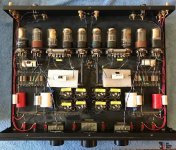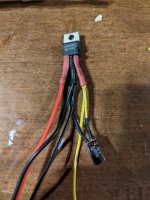For maximum sonic results, it is necessary to use ONE power supply for all channels. The widely spaced arrangement of inputs and outputs is in the way. In addition, that catches unnecessarily audible, sound-deteriorating channel imbalances)-;
Sorry)-;
Sorry)-;
Attachments
I use one per channel except on monoblocs, but a lot of people would say separate PSU per channel improves separation. I just decouple properly...
I found a pic of a 6550 amp I made before I did up PCBs... Except for some cheap caps, it was a good amplifier before I scrapped it.

You could simply connect the psus with a small wire. A difference should be heard. The higher sonic potential is with the connected power supplies, with one power supply. This is because the ear detects the channel imbalances through channel imbalanced components that channel imbalanced modulate the signal.
I normally connect all grounds of all RCA connectors straight to the metal enclosure. If you don't, the metal enclosure doesn't work as a shield against RF signals anymore.The best example: never use these screwed solder lugs. This gives away a lot of cleanliness, resolution and homogeneity. And with RCA, use only ONE channel to connect the ground. When using both channels, you have sound worsening larger cross-cuts, more undefined transitions, small hum loops, so not One circuit, and more.
Also, it looks like all the grounds are connected to this cabinet. Should it be so, then it is simply botched - and the result sonic garbage)-;
Sorry)-;
That works fine for low-frequency electric fields, but for high frequencies the wires from the grounds of the RCA connectors to the star ground point form coupling loops to couple RF interference into the inside of the enclosure.
I never use safety ground, by the way, but try to make everything double insulated. There are almost no sockets with safety ground in my house anyway, except in wet areas such as the kitchen.
I never use safety ground, by the way, but try to make everything double insulated. There are almost no sockets with safety ground in my house anyway, except in wet areas such as the kitchen.
In the UK - I have a CDP that doesn't have a protective earth ground - only grounding through the RCA/digital shielding.Interesting. In Canada its a no no to run anything but a lamp without safety ground.
We had those a few years ago as well. I converted them to 3 prong IEC when adding a tube output stage. And I still have double insulated power tools from the 80s. Cell phone chargers and alarm clocks, lamps and a few other things are double insulated but most everything has 3 prongs. Now even my laptop charger has 3 prongs.
I enjoy looking at the wiring of this Grommes mixer.




I built a cc cv power supply with a bunch of capacitance on the line side. I was worried about my ps switch contacts overloading so I added a relay in its place. The regulator takes the psu output voltage (hp laptop brick) and steps it down to 24 so I can run a Heavy duty automotive relay
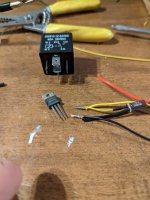
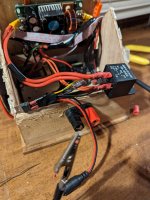 looks like a mess,but it's a functional mess and yes that's some k-nex pieces that my son donated for the hinged roof. (It's a birdhouse)
looks like a mess,but it's a functional mess and yes that's some k-nex pieces that my son donated for the hinged roof. (It's a birdhouse)
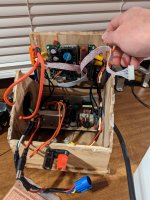 In the back is the laptop brick with a modified feedback loop that allowed a little higher output V. The top is the control unit. (Buck converter)
In the back is the laptop brick with a modified feedback loop that allowed a little higher output V. The top is the control unit. (Buck converter)
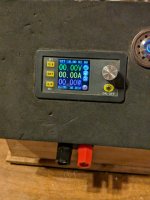 it's my prized piece that I use all the time. It's built in a craft store birdhouse. (Probably semi safe lol)
it's my prized piece that I use all the time. It's built in a craft store birdhouse. (Probably semi safe lol)

 looks like a mess,but it's a functional mess and yes that's some k-nex pieces that my son donated for the hinged roof. (It's a birdhouse)
looks like a mess,but it's a functional mess and yes that's some k-nex pieces that my son donated for the hinged roof. (It's a birdhouse) In the back is the laptop brick with a modified feedback loop that allowed a little higher output V. The top is the control unit. (Buck converter)
In the back is the laptop brick with a modified feedback loop that allowed a little higher output V. The top is the control unit. (Buck converter) it's my prized piece that I use all the time. It's built in a craft store birdhouse. (Probably semi safe lol)
it's my prized piece that I use all the time. It's built in a craft store birdhouse. (Probably semi safe lol)
Last edited:
Anyone ever see the inside of an analog vacuum tube computer? https://www.nutsvolts.com/magazine/article/restoring-the-heathkit-es-400-computer
- Home
- Amplifiers
- Tubes / Valves
- Point to point wiring
